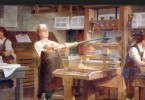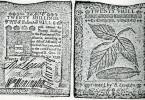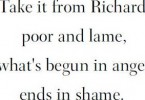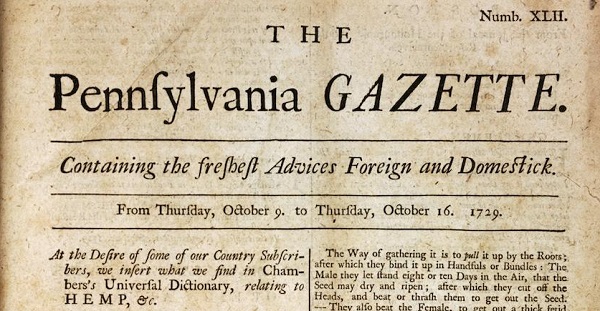
The Pennsylvania Gazette was founded in 1728 and ceased publication in 1800.
On October 2, 1729 Benjamin Franklin and his partner Hugh Meredith seized the opportunity to purchase the Pennsylvania Gazette from Samuel Keimer. The Pennsylvania Gazette was founded by Samuel Keimer in 1728 under the cumbersome name of The Universal Instructor in all Arts and Sciences: and Pennsylvania Gazette. Each copy was published with an insert of Ephraim Chambers’ Cyclopaedia, or Universal Dictionary of Arts and Sciences. The Cyclopaedia was one of the first general encyclopedias to be produced in English. Keimer sold his publication because he was greatly indebted due to other business ventures.
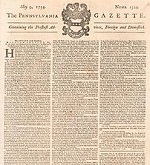
The Pennsylvania Gazette was founded in 1728 by Samuel Keimer.
The Gazette was the second newspaper published in Philadelphia, the first was American Weekly Mercury published by Andrew Bradford in 1723. Only three copies of the original issue are known to exist. They are in the Historical Society of Pennsylvania, the Library Company of Philadelphia, and the Wisconsin Historical Society. Under Franklin, the Gazette became the most successful newspaper in the colonies.
When Franklin and Meredith became its owners the title was shortened to The Pennsylvania Gazette. They also dropped Keimer’s ambition to publish Ephraim Chamber’s Cyclopaedia. Its appearance was improved with better types, articles and news resulting in an exponential growth in the number of subscribers. The Pennsylvania Gazette was published twice a week and contained news and reports on public events. What made this paper different from others was the publication of essays and letters from readers, much of which was written by Franklin himself under pseudonyms. He resisted making the Gazette partisan until the time leading up to the American Revolution.
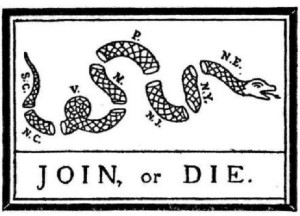
Join, or Die was the first political cartoon published in America by Benjamin Franklin in The Pennsylvania Gazette.
Franklin used the Gazette to publish his experiments with electricity. On October 19,1752 he published his electric kite experiment by which he proved that lightning and electricity are the same. He described how he constructed a kite with a conductor to draw electricity from a storm cloud and stored it in a Layden Jar.
He also used the Gazette to stress his political views. On May 19, 1754 during the French Indian War, Franklin published the first known American political cartoon known as Join, or Die as part of an editorial titled “The Disunited State”. In the editorial he tried to emphasized the need of the colonies to join forces with Great Britain to defeat the French and Indians. Ironically, one decade later as discontent in the colonies grew against British taxation, specifically the Stamp Act, the same cartoon became the symbol of American rebellion and the Revolutionary War. The cartoon shows a snake cut into eight parts, each one labeled with the initials of each American colony.
As Franklin moved up in his political career so did the profits of his business. Starting in 1736, when Franklin was chosen clerk of the General Assembly he was able to secure large scale, very profitable printing jobs such as votes, pamphlets and other general use forms. The Gazette saw a boost in its circulation in 1737 when Franklin was appointed Postmaster of Philadelphia. As Postmaster he was able to include The Pennsylvania Gazette in mail riders (mailmen) routes to be delivered with regular mail gaining a wider audience as well as increasing demand for paid advertising space. Business was thriving by the mid 1730s, the Pennsylvania Gazette became the most popular newspaper in the colony and Poor Richard’s Almanac was a best seller with a circulation of 10,000 copies a year.
In 1748 Franklin retired from business. Having built a fortune which enabled him to live comfortably for the rest of his life he decided to dedicate all his time to science and public projects. He left the management of his business to his partner David Hall including printing and editing of the Pennsylvania Gazette and Poor Richard’s Almanac.
The Pennsylvania Gazette ceased publication in 1800, ten years after Franklin’s death. Unrelated to the original Pennsylvania Gazette is the alumni on-line magazine of the University of Pennsylvania of which Franklin was a founder and a trustee.

